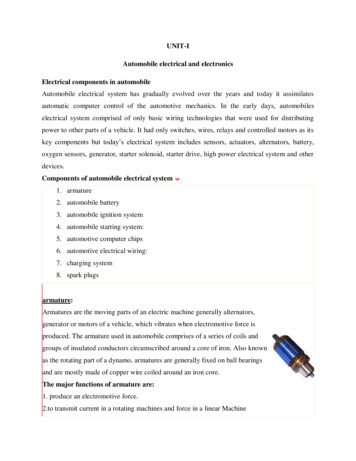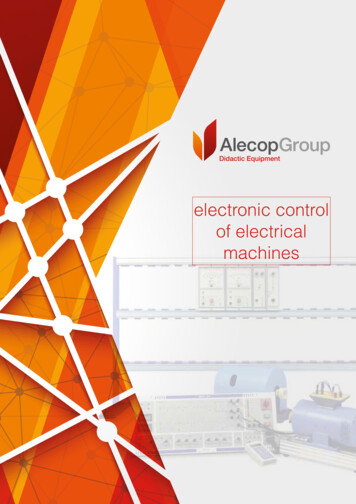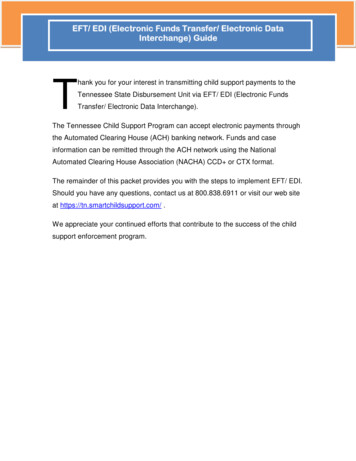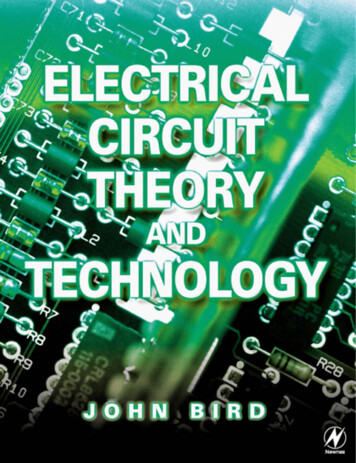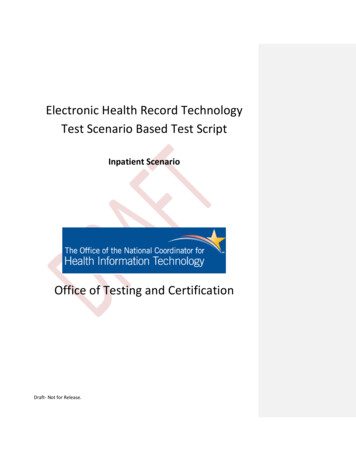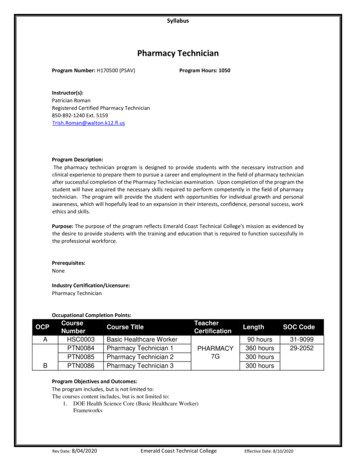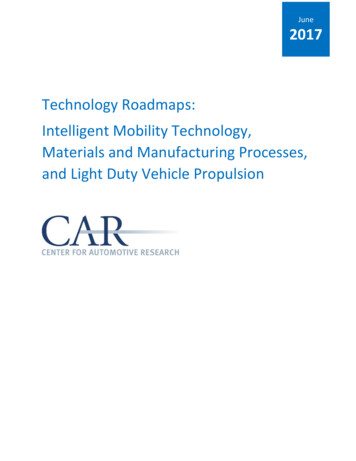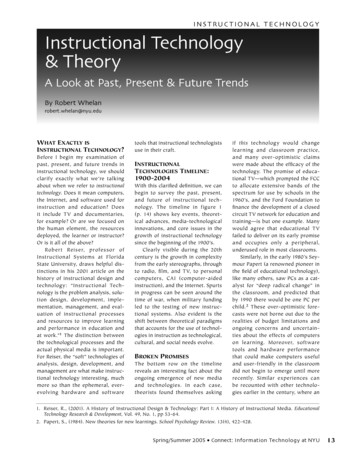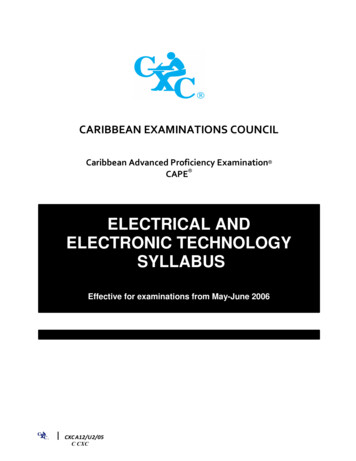
Transcription
CARIBBEAN EXAMINATIONS COUNCILCaribbean Advanced Proficiency Examination CAPEELECTRICAL ANDELECTRONIC TECHNOLOGYSYLLABUSEffective for examinations from May-June 2006CXCCXCA12/U2/05A12/U2/05C CXC
Published by the Caribbean Examinations CouncilAll rights reserved. No part of this publication may be reproduced, stored in a retrieval system, ortransmitted in any form, or by any means electronic, photocopying, recording or otherwise without priorpermission of the author or publisher.Correspondence related to the syllabus should be addressed to:The Pro-RegistrarCaribbean Examinations CouncilCaenwood Centre37 Arnold Road, Kingston 5, Jamaica, W.I.Telephone: (876) 630-5200Facsimile Number: (876) 967-4972E-mail address: cxcwzo@cxc.orgWebsite: www.cxc.orgCopyright 2005 by Caribbean ExaminationsCouncil The Garrison, St Michael BB14038, BarbadosCXC A12/U2/05
ContentsRATIONALE. . 1AIMS. . . 2SKILLS AND ABILITIES TO BE ASSESSED. . 2 - 3PRE-REQUISITES OF THE SYLLABUS . . 3STRUCTURE OF THE SYLLABUS . . 4UNIT 1: ELECTRICAL THEORY AND COMMUNICATIONSMODULE 1: DC CIRCUIT THEORY. . .5 - 9MODULE 2: ANALOGUE ELECTRONICS AND COMMUNICATIONS.10 - 14MODULE 3: INTRODUCTION TO POWER SYSTEMS. .17 - 22UNIT 2: ENERGY CONVERTERS AND LOGIC CIRCUITSMODULE 1: AC CIRCUIT THEORY . . . 23 - 26MODULE 2: DIGITAL ELECTRONICS AND DATA COMMUNICATIONS.27 - 34MODULE 3: INTRODUCTION TO AC MACHINES . . .35 - 38OUTLINE OF ASSESSMENT. . .39 - 47SUGGESTED LABORATORY EXERCISES FOR PROJECTS . .48 - 51REGULATIONS FOR PRIVATE CANDIDATES . . . . .52REGULATIONS FOR RESIT CANDIDATES . . . 52ASSESSMENT GRID . 52GLOSSARY OF ACRONYMS/TERMS FOR ELECTRICAL AND ELECTORNIC TECHNOLOGY .53 - 54APPENDIX 1: Minimum Equipment List . .55APPENDIX 2: Symbols, Abbreviations, Definitions and Diagrammatic Symbols. . . . . 56 – 64CXC A12/U2/05
This document CXC A12/U2/05 replaces CXC A12/U1/99 issued in 1999.First issued in 1999Revised 2005Please check the website, www.cxc.org for updates on CXC’s syllabuses.CXC A12/U2/05
TIntroductionThe Caribbean Advanced Proficiency Examination (CAPE) is designed to provide certification ofthe academic, vocational and technical achievement of students in the Caribbean who, havingcompleted a minimum of five years of secondary education, wish to further their studies. Theexaminations address the skills and knowledge acquired by students under a flexible and articulatedsystem where subjects are organised in 1-Unit or 2-Unit courses with each Unit containing three Modules.Subjects examined under CAPE may be studied concurrently or singly.The Caribbean Examinations Council offers three types of certification. The first is the award of acertificate showing each CAPE Unit completed. The second is the CAPE diploma, awarded to candidateswho have satisfactorily completed at least six Units, including Caribbean Studies. The third is the CAPEAssociate Degree, awarded for the satisfactory completion of a prescribed cluster of seven CAPE Unitsincluding Caribbean Studies and Communication Studies. For the CAPE diploma and the CAPE AssociateDegree, candidates must complete the cluster of required Units within a maximum period of five years.Recognised educational institutions presenting candidates for CAPE Associate Degree in one of the ninecategories must, on registering these candidates at the start of the qualifying year, have them confirmin the required form, the Associate Degree they wish to be awarded. Candidates will not be awardedany possible alternatives for which they did not apply.CXC A12/U2/05
Electrical and ElectronicTechnology Syllabus RATIONALEModern civilization as we know it would not exist without electricity and the attendanttechnologies that have arisen out of it, for example, communications (voice, data, Internet),computer and electronic technologies. Just imagine the world without electricity and, therefore,without refrigeration, television, hi-fi stereo, computer, Internet or telephones. Electrical andelectronic technology is the common thread that connects these diverse areas and those of airtravel, transportation, manufacturing, mining, construction, agriculture, sports, education,medicine, entertainment, food preservation and preparation.None of these modern marvels of the world is possible without the use of electrical and electronictechnology. Therefore, it is imperative that persons, wishing to understand the rapid pace oftechnological advancement, have a good grasp of the fundamentals of electrical and electronictechnology.The CAPE Electrical and Electronic Technology syllabus is designed to provide the fundamentalknowledge necessary for a lifelong career in the dynamic and exciting field of Electrical andElectronic Technology. More particularly, for the continued development of the Caribbean and itscitizenry, it is necessary for students to be exposed to subject areas that embody currenttechnological trends and practices of the wider world. The CAPE Electrical and ElectronicTechnology syllabus, therefore, seeks to address this need by offering advanced technical andvocational training that would prepare students for the world of work. It also seeks to satisfy theprerequisite for further training as technicians and engineers in specific areas.The CAPE Electrical and Electronic Technology syllabus is expected to:(i)facilitate articulation with this field of study provided by institutions of higherlearning such as universities, community colleges, technical institutes and teachers’colleges;(ii)provide a means whereby persons, with an interest and commitment to the field ofElectrical and Electronic engineering, can upgrade their previously acquired knowledgebase and skills;CXC A12/U2/051
(iii)encourage further development of analytical, problem-solving and experimentalabilities;(iv)equip students with fundamental knowledge for the world of work in the electrical andelectronic field;(v)provide the foundation for further career development.The syllabus also contributes to the development of selected attributes from the CARICOM Ideal Persondocument as articulated by the CARICOM Heads of Government. This person is one who demonstratesemotional security with a high level of self-confidence and self-esteem, is aware of the importance ofliving in harmony with the environment and nurtures its development in the economic andentrepreneurial spheres in all other areas of life (CARICOM Education Strategy, 2000).This holistic development of students aligns with selected competencies advocated in the UNESCOPillars of learning. These are learning to be, learning to do, and learning to transform one’s self andsociety. AIMSThis syllabus aims to:1.develop an interest in, and an awareness of, career choices and options for furtherstudy in the field of Electrical and Electronic Engineering;2.develop analytical, practical and experimental skills in the use of electrical andelectronic technology in industry;3.develop an awareness of practical applications of electricity and electronics within industry;4.provide opportunities for the acquisition of advanced knowledge of the concepts andfundamentals of electricity and electronics;5.encourage the adoption of specific safety practices;6.inculcate an appreciation of the pivotal role of electricity in the socio-economicdevelopment of their country and the region. SKILLS AND ABILITIES TO BE ASSESSEDThe Skills and Abilities which students are expected to develop on completion of thesyllabus have been grouped under three headings:(i)(ii)(iii)Knowledge;Use of Knowledge;Practical Ability.CXC A12/U2/052
KnowledgeThe ability to recall and comprehend facts, principles, methods,procedures, theories and structures; interpolation and extrapolation.Use of KnowledgeThe ability to:Applicationuse facts, concepts, principles and procedures in unfamiliarsituations, transform data accurately and appropriately; useformulae accurately for computations;Analysis and Interpretationidentify and recognise the component parts of a whole andinterpret the relationship between those parts; identify causalfactors and show how they interact with each other; infer, predictand draw conclusions; make necessary and accurate calculations andrecognise the limitations and assumptions of data;Synthesiscombine component parts to form a new meaningful whole; makepredictions and solve problems;Evaluationmake reasoned judgements and recommendations based on thevalue of ideas and information and their implications.Practical AbilityThe ability to use electrical and electronic equipment and tools tofabricate simple circuits, test and determine circuit parameters andgather and analyse data. PRE-REQUISITES OF THE SYLLABUSIt is expected that persons who have completed the CSEC syllabuses in Physics or Electricaland Electronic Technology or their equivalent should be able to pursue this course successfully.CSEC Mathematics or its equivalent would be a strong asset for those who wish to undertake thiscourse.CXC A12/U2/053
STRUCTURE OF THE SYLLABUSThe syllabus is divided into two Units. Each Unit consists of three Modules. The Units areindependent of each other. However, together they provide a comprehensive post-secondarycourse in the field of Electrical and Electronic Technology.Unit 1: Electrical Theory and Communications, contains three Modules of approximately 50hours each. The total teaching time for the syllabus is approximately 150 hours.Module 1:Module 2:Module 3:DC Circuit TheoryAnalogue Electronics and CommunicationsIntroduction to Electrical Power SystemsUnit 2: Energy Converters and Logic Circuits, contains three Modules of approximately 50 hourseach. The total teaching time for the syllabus is approximately 150 hours.Module 1:Module 2:Module 3:AC Circuit TheoryDigital Electronics and Data CommunicationsIntroduction to AC MachinesIt is strongly advised that Unit 1 or an equivalent course be completed before Unit 2.CXC A12/U2/054
UNIT 1: ELECTRICAL THEORY AND COMMUNICATIONSMODULE 1: DC CIRCUIT THEORYGENERAL OBJECTIVESOn completion of this Module, students should:1.understand the basic principles of circuit analysis;2.appreciate the use of passive components.DC THEORYSPECIFIC OBJECTIVESStudents should be able to:1.explain Ohm's Law;2.calculate the equivalent resistance of resistors in series, parallel and series-parallel;3.derive and use the voltage and current divider principles to solve problems;4.carry out calculations using Ohm’s law for resistors in series, parallel and series-parallel;5.derive and apply the relationships P V2R-1 I2R IV to calculate the power dissipatedby circuit elements;6.derive the relationship between resistance and its physical factors;7.recall and use the temperature dependence relationship Rθ R0 (1 αθ)in simplecalculations;8.apply Kirchoffs' Laws for the analysis of DC networks involving two meshes;9.use the following theorems, for a maximum of two independent sources and meshes inthe solution of DC networks: Norton's, Superposition, Thevenin's, Maximum PowerTransfer.CXC A12/U2/055
UNIT 1MODULE 1: DC CIRCUIT THEORY (cont’d)CONTENT(i)Ohm's law.(ii)Series, Parallel and Series-parallel resistor circuits.(iii)Power calculations.(iv)Specific resistance.(v)Temperature coefficient of resistance.(vi)Kirchoffs' laws.(vii)Superposition theorem.(viii)Thevenin's theorem and Norton's theorem.(ix)Maximum Power Transfer theorem.ELECTROSTATICSSPECIFIC OBJECTIVESStudents should be able to:1.derive formulae for capacitance in series and parallel and use these formulae to solveproblems;2.determine the relationship between capacitance and its dimensions;3.define the terms: electric field strength, electric flux density, permittivity of free spaceand relative permittivity and use these terms in the solution of problems;4.determine the capacitance for fixed and variable capacitors;CXC A12/U2/056
UNIT 1MODULE 1: DC CIRCUIT THEORY (cont’d)5.recall and use formulae for time constant and sketch curves for charging and dischargingcapacitors;6.derive the formula for the energy stored in a capacitor and use it to solve problems.CONTENT(i)Capacitance in series and parallel.(ii)Relationship between capacitance and its dimensions.(iii)Electric field strength.(iv)Electric flux density.(v)Permittivity.(vi)Construction of fixed and variable capacitors.(vii)Charging and discharging a capacitor.(viii)Time constant.(ix)Energy stored in a capacitor.INDUCTANCESPECIFIC OBJECTIVESStudents should be able to:1.state the physical factors governing inductance;2.derive the formula for inductance given its physical factors;3.calculate the total inductance for inductors in series, parallel and combinations;4.use Helmholtz equation for simple RL circuits;CXC A12/U2/057
UNIT 1MODULE 1: DC CIRCUIT THEORY (cont’d)5.derive the formula for energy stored in an inductor and use it to solve problems;6.explain the concepts of self-inductance and mutual-inductance and their relationship;7.explain the function of the core-material in an inductor with particular reference to theiron-core inductor or choke;8.define the concept of the coupling coefficient with particular reference to coils inductivelycoupled in series;9.explain additive and subtractive polarity.CONTENT(i)Physical factors governing inductance.(ii)Inductors in series and parallel.(iii)RL circuits.(iv)Energy stored in an inductor.Suggested Teaching and Learning ActivitiesTeachers are encouraged to engage students in activities such as those listed below as they seekto achieve the objectives of this Module.1.Have students solve problems to enhance their understanding of the Module.2.Encourage students to read related material to complement work done in class.3.Use appropriate analogies to introduce the concept of current flow, as this will set thefoundation for a thorough understanding of not only Ohm’s Law, but also the greater partof this Module.4.Model circuits, wherever possible, after the actual problems given in theory, so thattests can be carried out on these circuits to verify answers obtained from calculations.CXC A12/U2/058
UNIT 1MODULE 1: DC CIRCUIT THEORY (cont’d)5.Give weekly assessments to have an indication as to whether material taught waslearnt, especially those related to the analysis of circuits using the theorems.6.Use real life examples to promote discussions and illustrate the use and purpose of thetheorems in the real world, for example, a talk by a practising power engineer where hediscusses how he uses Thevinin's and Norton's theorems in his everyday work would behelpful.The teacher is urged to reinforce the relevant approved codes and safety practices during thedelivery of the Module. It should be made clear that safety in the handling of electricity is ofparamount concern and should be the common thread connecting every topic.RESOURCEHughes, EdwardHall, 2002.Electrical and Electronic Technology, New Jersey: PrenticeCXC A12/U2/059
UNIT 1MODULE 2: ANALOGUE ELECTRONICS AND COMMUNICATIONSGENERAL OBJECTIVESOn completion of this Module, students should:1.understand the operation of basic electronic components;2.appreciate the various methods of modulating EM waves for communication.SEMICONDUCTOR DIODESSPECIFIC OBJECTIVESStudents should be able to:1.distinguish between n-type and p-type semiconductors;2.explain the current flow and conduction process in semiconductor materials;3.design and construct full and halfwave rectifier circuits and explain their function;4.solve simple problems on ripple factor;5.describe the operation of circuit limiters and clipping circuits;6.show quantitatively the applications of a zener diode as a voltage regulator.CONTENT(i)Doping: p-type and n-type semi-conductors.(ii)Current flow and conduction process in semi-conductor materials.(iii)The p-n-junction and depletion layer.(iv)Junction potential difference.(v)The p-n junction under bias.CXC A12/U2/0510
UNIT 1MODULE 2: ANALOGUE ELECTRONICS AND COMMUNICATIONS (cont’d)(vi)Diode circuit models - the ideal model, the constant voltage model, the Shockley model.(vii)Avalanche multiplication.(viii)Zener diode.(ix)Varactor diode.(x)LED.(xi)Rectification(halfwave, fullwave {two- and four-diode} circuits).(xii)Circuit limiters.(xiii)Clipping circuits.(xiv)Logic circuit applications - OR and AND gates.BIPOLAR JUNCTION TRANSISTORSPECIFIC OBJECTIVESStudents should be able to:1.distinguish between PNP and NPN transistors;2.draw typical transistor characteristics curves;3.explain the operating regions of a transistor;4.design and construct the biasing network of a common emitter amplifier;5.perform load line analysis;6.draw the small signal common emitter (CE) amplifier model using h-parametes andperform calculations to determine: input impedance, output impedance, voltage gain andcurrent gain.CXC A12/U2/0511
UNIT 1MODULE 2: ANALOGUE ELECTRONICS AND COMMUNICATIONS (cont’d)CONTENT(i)PNP and NPN transistors.(ii)Terminal properties of a transistor.(iii)Operating regions of a transistor.(iv)Transistor characteristic curves.(v)Transistor biasing.(vi)H-Parameter model of a transistor.(vii)Transistor applications.(viii)Load line analysis.(ix)Small signal amplifier circuits.OPERATIONAL AMPLIFIERSSPECIFIC OBJECTIVESStudents should be able to:1.explain the operation of an operational amplifier used as a summing amplifier, acomparator, a differentiator and an integrator (quantitative analysis is expected);2.derive the relationship for the gain of the inverting and the non-inverting op-ampand solve problems;3.draw circuit diagram for the Wein Bridge RC and Hartley LC oscillators anddetermine the frequency of oscillation.CXC A12/U2/0512
UNIT 1MODULE 2: ANALOGUE ELECTRONICS AND COMMUNICATIONS (cont’d)CONTENT(i)Definition of parameters and input/output quantities.(ii)Single stage model.(iii)Cascade connection.(iv)Positive feedback.(v)Criteria for oscillation.(vi)Oscillators: RC and LC oscillators.(vii)Differential amplifiers.(viii)Inverting and non-inverting amplifiers.(ix)Operational amplifiers, transfer characteristics, negative feedback, differentiator andintegrator circuits and comparators.ELECTROMAGNETIC (EM) WAVESSPECIFIC OBJECTIVESStudents should be able to:1.explain how EM waves propagate from an antenna;2.distinguish between ground waves, sky waves and space waves;3.list the various wavebands in use and the services utilising them.CXC A12/U2/0513
UNIT 1MODULE 2: ANALOGUE ELECTRONICS AND COMMUNICATIONS (cont’d)CONTENT(i)Propagation of EM waves.(ii)Ground waves.(iii)Sky waves and space waves.(iv)Ionospheric reflections.(v)Major wavebands and their uses.MODULATIONSPECIFIC OBJECTIVESStudents should be able to:1.explain the principle of amplitude and frequency modulation;2.perform simple calculations on modulation index for AM/FM;3.compare and contrast AM and FM systems;4.describe operation of AM and FM modulators and demodulators;5.draw block diagrams of AM and FM receivers and explain their operation.CONTENT(i)Amplitude modulation: double sideband (DSB), single (SSB) modulators anddemodulators, narrowband and broadband AM.(ii)The superheterodyne radio receiver.(iii)Frequency modulation: FM modulator and demodulator.CXC A12/U2/0514
UNIT 1MODULE 2: ANALOGUE ELECTRONICS AND COMMUNICATIONS (cont’d)Suggested Teaching and Learning ActivitiesTeachers are encouraged to engage students in activities such as those listed below as they seekto achieve the objectives of this Module.1.Encourage students to research various topics and present to the class in interactivesessions.2.Have students solve problems from the suggested texts and other reference material.3.Demonstrate plotting of the characteristic curves of a common emitter transistor.4.Encourage students to visit and discuss with engineers and other professionals varioustopics and issues relating to the subject matter.5.Encourage students to prepare oral and written reports that make use of the technicallanguage.6.Organise field trips to local Telecommunications companies, IT service companies ororganizations with data and communication networks.7.Form working relationships with engineers in related fields who can advise andassist in the delivery of the subject matter.8.Organise a mentoring program with professional organizations and relevant companies.9.Seek sponsorship from industry for students’ projects.10.Direct students to relevant Websites that offer practical guidance in the area, forexample, www.howstuffworks.com.11.Encourage students to do the suggested laboratory exercises listed on pages 45-48.These exercises can be done either as individual or group activities.The teacher is urged to reinforce the relevant approved codes and safety practices during thedelivery of the Module. It should be made clear that safety in the handling of electricity is ofparamount concern and should be the common thread connecting every topic.CXC A12/U2/0515
UNIT 1MODULE 2: ANALOGUE ELECTRONICS AND COMMUNICATIONS (cont’d)RESOURCEHughes, EdwardHall, 2002.Electrical and Electronic Technology, New Jersey: PrenticeCXC A12/U2/0516
UNIT 1MODULE 3: INTRODUCTION TO POWER SYSTEMSGENERAL OBJECTIVESOn completion of this Module, students should:1.understand the relationship between electricity and magnetism;2.appreciate the importance of protection schemes in energy systems;3.understand the operation and control of DC machines;4.appreciate the application of communications and controls in the management of powersystems.ELECTROMAGNETISMSPECIFIC OBJECTIVESStudent should be able to:1.differentiate between magnetic flux and magnetic flux density;2.describe with the aid of relevant sketches the concept of lines of magnetic flux;3.explain the magnetic effect on a current carrying conductor;4.recall and use the relation F BIL Sin θand solve problems;5.explain Faraday’s and Lenz’s laws;6.calculate the emf generated in a conductor within a magnetic field;7.explain electromagnetic induction;8.distinguish among the concepts of: permeability (free space, relative), magnetomotiveforce, magnetizing force (field intensity, field strength) and reluctance.9.sketch and label a typical B-H curve;10.apply B-H curve to calculate magnetic circuit characteristics for a simple toroid.CXC A12/U2/0517
UNIT 1MODULE 3: INTRODUCTION TO POWER SYSTEMS (cont’d)CONTENT(i)Magnetic flux.(ii)Flux density.(iii)Permeability of free space.(iv)Relative permeability.(v)Force on a current carrying conductor in a magnetic field.(vi)Magnetomotive force.(vii)Reluctance, B-H Curves, magnetic circuits, Faraday's and Lenz's law.DC ROTATING EQUIPMENTSPECIFIC OBJECTIVESStudents should be able to:1.describe the essential features in the construction of a conventional DC machine;2.describe the principle of operation of a DC machine in terms of the equation Tω Erla,where T torque, ω angular velocity, E emf, and Ia armature current and solveproblems;3.explain the meaning of armature reaction and commutation as applied to DC machines;4.differentiate between the various methods of excitation with reference to thefield winding connection and draw the respective circuits;5.sketch and explain the open-circuit and no-load characteristics for various windingconnections of the DC machine;6.sketch the torque speed characteristic of series, shunt and compound wound DC machinesand solve problems;CXC A12/U2/0518
UNIT 1MODULE 3: INTRODUCTION TO POWER SYSTEMS (cont’d)7.describe various methods of varying the speed of a DC machine using the terminalvoltage and excitation current;8.list the main uses of a DC machine.CONTENT(i)The emf equation.(ii)Armature reaction.(iii)Commutation.(iv)The DC generator - methods of excitation.(v)Open-circuit characteristic.(vi)Load characteristics.(vii)The DC motor speed/torque characteristics.(viii)Speed control.(ix)Losses.(x)Conditions for maximum efficiency.(xi)Uses.CXC A12/U2/0519
UNIT 1MODULE 3: INTRODUCTION TO POWER SYSTEMS (cont’d)INTRODUCTION TO POWER SUPPLY PROTECTIONSPECIFIC OBJECTIVESStudents should be able to:1.distinguish among the concepts of continuous current, overload current and fault current;2.explain the function and operation of a fuse and the relationship of continuous, overloadand fault current to the fuse rating;3.explain the operation of the thermal overload relay;4.explain the operation of the inverse minimum time over-current relay;5.sketch the inverse characteristics of the fuse, the thermal overload relay and the inverseover-current relays;6.identify typical areas within the power supply system where fuses and circuit breakers areused;7.explain the operation of the voltage surge protector and its uses;8.explain the function and uses of the frequency, under-voltage and over-voltage relays.CONTENT(i)The relationships between continuous, overload and fault currents.(ii)Fuses.(iii)Over-current relays.(iv)Frequency relays.(v)Under-voltage and over-voltage protection.(vi)Thermal relays.CXC A12/U2/0520
UNIT 1MODULE 3: INTRODUCTION TO POWER SYSTEMS (cont’d)INTRODUCTION TO SUPERVISORY CONTROL AND DATA ACQUISITION (SCADA) SYSTEMSSPECIFIC OBJECTIVESStudents should be able to:1.describe the basic principles of data communications (simplex and duplex);2.list the advantages of using digital communication over analogue communication;3.explain the need for SCADA system as applied to electricity generation, transmission andthe central control room;4.draw a simple block diagram to represent a SCADA system and explain the function of eachblock;5.describe the various communications methods between the field and central control rooms;6.explain telemetering;7.outline the role of computers in SCADA systems.CONTENT(i)Communications as applied to power system.(ii)Power line carrier.(iii)Leased lines.(iv)Radio waves.(v)Telemetering.CXC A12/U2/0521
Suggested Teaching and Learning ActivitiesTeachers are encouraged to engage students in activities such as those listed below as they seekto achieve the objectives of this Module.1.Have students identify, wherever possible, equipment within the home environment thatoperates on the principles addressed in each section of the Module.2.Demonstrate the Induction Laws in the laboratory.3.Encourage students to visit a utility company to observe aspects of the Module at work inindustry.4.Have students use “free access” Websites where valuable information can be ascertained(for example, www.howstuffworks.com).5.Encourage students to research the various topics and present to class in interactivesessions.6.Have students share with each other (or in small groups) their understanding of varioustopics.7.Encourage students to solve mathematical problems using the applicable methods available.8.Invite technical and vocational instructors, practising engineers or specialists fromindustry and tertiary institutions to lecture on areas such as Power Supply Protection andSCADA Systems.9.Visit a local motor rewind shop, where sections of DC motors can be obtained fordemonstration.10.Encourage students to attempt the suggested laboratory exercises listed on pages 4548.These exercises can be attempted either as individual or group activities.The teacher is urged to reinforce the relevant approved codes and safety practices during thedelivery of the Module. It should be made clear that safety in the handling of electricity is ofparamount concern and should be the common thread connecting every topic.RESOURCEHughes, EdwardElectrical and Electronic Technology, New Jersey: Prentice Hall, 2002.CXC A12/U2/0522
UNIT 2: ENERGY CONVERTERS AND LOGIC CIRCUITSMODULE 1: AC CIRCUIT THEORYGENERAL OBJECTIVESOn completion of this Module, students should:1.understand the principles of AC theory;2.develop the ability to apply AC theory to the analysis of RLC circuits.AC THEORYSPECIFIC OBJECTIVESStudents should be able to:1.define and determine: frequency, period, amplitude, instantaneous value, rms value,average value with reference to an AC sinusoidal wave;2.define a phasor and represent it diagrammatically;3.add and subtract phasors;4.draw and interpret waveforms and phasor diagrams for alternating currents and voltagesin resistive, inductive and capacitive circuits;5.define: volt-ampere, apparent active and reactive power for purely inductive andinductive resistive loads;6.calculate volt-ampere, apparent active and reactive power for purely inductive andinductive resistive loads;7.determine capacitor values to be applied in parallel for improving power factor.CONTENT(i)Definition of: period, frequency, rms value, amplitude and average value.(ii)Power in AC circuits - non-inductive and purely inductive; apparent active and reactivepower.CXC A12/U2/0523
UNIT 2MODULE 1: AC CIRCU
Technology syllabus, therefore, seeks to address this need by offering advanced technical and vocational training that would prepare students for the world of work. It also seeks to satisfy the prerequisite for further
